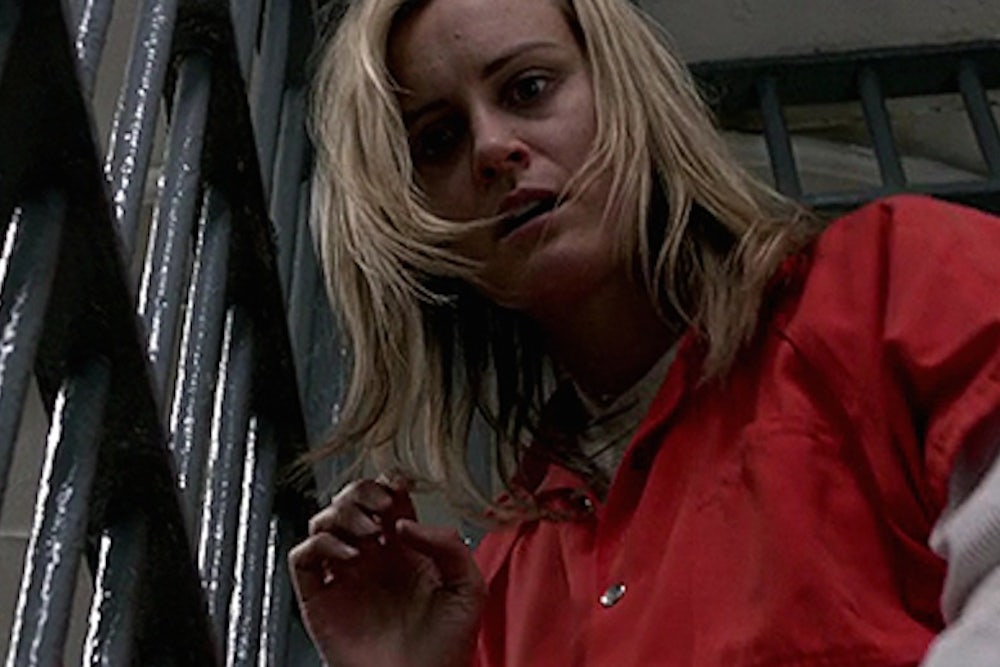There’s no shortage of unsavory characters on "Orange Is the New Black"'s second season, but Yoda—the cockroach trained by the inmates to act as a courier—might be one of the least pleasant to watch on screen. OITNB has never been known for its realism, but just how much of a stretch is it to imagine that prisoners could teach a roach to shuttle cigarettes and other trinkets back and forth between cells?
Experienced entomologists can manipulate cockroaches’ behavior to some degree by adjusting factors like the temperature, odor, and amount of light in their environment. Tom Turpin, a professor of entomology at Purdue University, told me how he and his team train Madagascar cockroaches—one of the largest species of cockroach in the world—to pull tractors ten times their own weight, as part of a spectacle for an annual insect festival held at Purdue. “We keep them in the dark,” explained Turpin. “Once they’re in the light, they run to try to find a place to hide, to get out of the light. They’re running to get out of that particular stimulus—like if you gave them an electric shock.”
The type of roach most common in unsanitary industrial settings like prisons, according to Turpin, is the American cockroach. (The smaller German cockroach is the kind you’re more likely to find at home.) Turpin believes an American cockroach—which is typically about an inch long—would be able to support the weight of something like a cigarette, but he’s skeptical that it could be trained to carry its load to a specific location; it’s much easier to get a roach to run away from a negative stimulus than go toward a positive one.
Some scientists are more optimistic about the prisoners’ chances. “I think that roaches certainly have the mental ability to learn all the component tasks that would make up this scenario,” said Cole Gilbert, an entomologist at Cornell University. “It would just take a lot of training, and no one has demonstrated this yet. With the caveat that I have not seen what is actually being portrayed, I think that roaches could be trained to go from A to B and back to A if they were neighboring cells.” In the 1990s, Gilbert was a researcher in a University of Arizona neurobiology lab where biologists, led by Nick Strausfeld, managed to train roaches to go to a specific location. Strausfeld and his team found that if they placed roaches on a hot surface—a metal sheet over boiling water—that had one cool area, the roaches would scurry around and eventually find the cold spot on the floor. After many trials, most of the roaches learned to run straight to the cool spot.
In 2007, a team of biologists at Vanderbilt University used olfactory conditioning to train roaches to run toward a solution smelling of peppermint. The researchers presented roaches with two substances: a peppermint-scented sucrose solution or vanilla-scented salt-water. Unconditioned roaches prefer the scent of vanilla to peppermint, but by the end of this, they ran toward the peppermint, which they had come to associate with the positive stimulus of sugar.
The lead author of the study, Professor Terry Page, isn’t convinced that inmates would be able to achieve this result on their own. “That seems rather implausible,” he wrote in an email. “We train them to approach one odor preferentially over another odor in an enclosed arena by placing a food reward at one of the odors. But it seems rather unlikely that one could attach a cigarette on a cockroach and turn it loose in a prison, and expect it deliver it reliably to another cell—think you’d lose a lot of cigarettes trying to use that method!”
Dini Miller, an entomology professor who spent five years working with cockroaches at a University of Florida lab in the 1990s, pointed out other practical issues. For the type of conditioning Page carried out to succeed, for instance, the roaches need to be starving—and it isn’t so easy to starve a roach. “You couldn't attract it to another cell with food if there was food already in the cell they were in,” she said. And even if the inmates have nothing but time on their hands, the cockroaches are on a tighter schedule: The life span of an American roach, Miller told me, is only about two years. She also emphasized the patience requisite for working with roaches. “The problem with cockroaches,” she said, “is whenever you try to get them to do anything, all they do is try to escape.” She recalled having to hold the roaches in a cup for up to two hours to calm them down. “Training a cockroach in prison, I would have to wish them extreme luck.”
